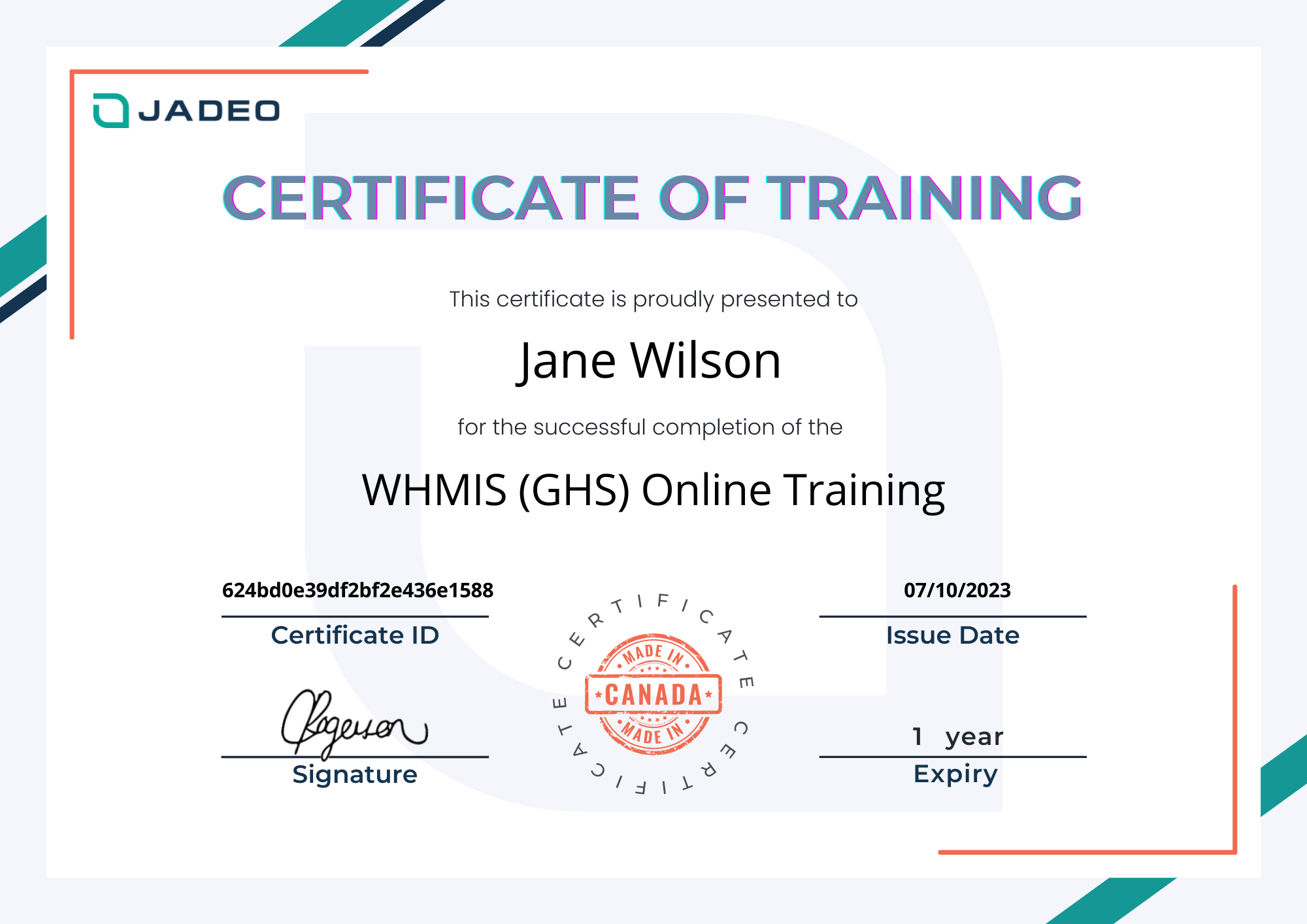Our Course
Digital and Printable Certification

-
Wall Certificate
Our wall certificate is a professionally designed document that can be proudly displayed in your workplace, showcasing your commitment to safety and compliance. It serves as a visual testament to your dedication to maintaining a safe work environment.
Whether you're on the job or attending off-site training sessions, having a digital certificate ensures that you have proof of your WHMIS training readily available.
“Tell me and I forget, teach me and I may remember, involve me and I learn.”
Unforgettable Learning Experiences
Reimagine Learning with Video
Seamless Navigation
Experience a smooth journey through our learning course with intuitive navigation. Effortlessly explore modules, access resources, and track progress through user-friendly menus, making learning a breeze.
Accessible Transcription
Prioritizing inclusivity, our courses feature transcriptions to accommodate various learning preferences and abilities. Engage with content using audio or review text transcripts for a comprehensive understanding.
Interactive Learning
Immerse yourself in dynamic videos and engaging quizzes. Reinforce the application of key concepts through interactive elements that make learning enjoyable and effective, thereby enhancing knowledge retention.
Beautiful course player
In-Course Discussions
Foster collaboration in our learning environment. Engage in meaningful discussions with fellow learners and knowledgeable admins. Ask questions, share insights, and exchange valuable perspectives within each learning unit.
Adaptable Paths to Success
Tailor your learning journey with flexible pathways. Whether you prefer a structured approach or the freedom to explore at your pace, our platform lets you customize your path to success. Achieve your goals on your terms.
Unlimited Exam Attempts
Learn at your own pace, enjoying the advantage of unlimited examination attempts. This flexibility ensures mastery, allowing you to approach examinations with confidence, unburdened by the constraints of time pressure.
Frequently Asked Questions
What is WHMIS?
WHMIS stands for the Workplace Hazardous Materials Information System, providing health and safety information on hazardous products used in Canadian workplaces.
WHMIS has embraced the globally recognized hazard communication system called GHS, which stands for the Globally Harmonized System of Classification and Labelling of Chemicals. Embracing GHS offers numerous advantages, such as:
WHMIS has embraced the globally recognized hazard communication system called GHS, which stands for the Globally Harmonized System of Classification and Labelling of Chemicals. Embracing GHS offers numerous advantages, such as:
- Enhanced hazard classification criteria that provide a more comprehensive assessment of the severity of hazards.
- Introduction of new hazard classes to encompass a wider range of potential risks.
- Consistent alignment of physical hazard criteria with the regulations for the Transport of Dangerous Goods (TDG).
- Implementation of standardized language for hazard and precautionary statements.
- Adoption of a standardized SDS (Safety Data Sheet) format and more comprehensive requirements.
Is WHMIS training mandatory? Who should receive WHMIS education and training?
All workers who handle or may be exposed to hazardous products in Canadian workplaces must receive WHMIS education and training. It is crucial that workers understand the associated product hazards and can work safely with such products.
For instance, education and training should be extended to the following categories of workers:
- Those who may encounter hazardous products during their work activities, including regular use, maintenance tasks, or emergency situations.
- Individuals who use, store, handle, or dispose of hazardous products.
- Supervisors or managers responsible for overseeing workers who might face exposure or engage in the use, storage, handling, or disposal of hazardous products.
- Personnel involved in emergency response procedures.
What does successful education / training look like?
Workers should understand product hazards, know how to protect themselves, respond to emergencies, and identify further information sources for hazardous products.
Workers must possess the knowledge to address the following inquiries concerning each hazardous product they handle:
Workers must possess the knowledge to address the following inquiries concerning each hazardous product they handle:
- What are the potential hazards associated with the product?
- How can I safeguard myself against these hazards?
- What steps should I take in the event of an emergency?
- Where can I access additional information for further clarification?
Become a Super Learner
Write your awesome label here.
Sign Up to Our Newsletter and Get Exclusive Discounts
Gain access to expert articles, practical tips, discount offers, and regulatory updates that can enhance your understanding of workplace safety and help you implement effective safety measures.
Whether you're an employer, safety professional, or an employee seeking to prioritize safety, our newsletter is a valuable resource that empowers you with the knowledge to create a safer work environment.
Whether you're an employer, safety professional, or an employee seeking to prioritize safety, our newsletter is a valuable resource that empowers you with the knowledge to create a safer work environment.
Thank you!
Write your awesome label here.
